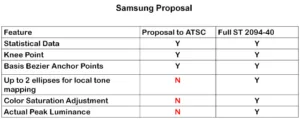Bill Mandel then gave a second presentation mainly prepared by his colleague, Jon Fairhurst. This talk began with an overview of some of the benefits of the ATSC 3.0 format with the expectation that the full standard will be approved before the end of 2017. Trial broadcasts will start soon thereafter, including the Winter Olympics in Korea – an ATSC 3.0 adopter country.
The standard allows for object-based audio with Dolby AC-4 or MPEG-H optional depending upon the region. Progressive video up to UHD resolution is supported with PQ or HLG EOTFs and BT.709 or Bt.2020 color encoding.
Regarding adding dynamic metadata to the standard, Samsung says it has proposed a version of ST-2940-40 to the ATSC TG3 S34-1 working group. This is summarized in the table below.
For workflow, Mandle said the metadata can be generated at the end of the production at the encoder using an automated process with a target display for quality control review*. He concluded by noting that HDR10+ is compatible with existing workflows with low complexity allowing for an improved HDR image.
(This is the architecture proposed by Dolby at NAB, and reinforced at IBC, that avoids the need for metadata in live broadcasts, a major objection against PQ by broadcasters and one of the key reasons that HLG has also been widely adopted for HDR BR).

